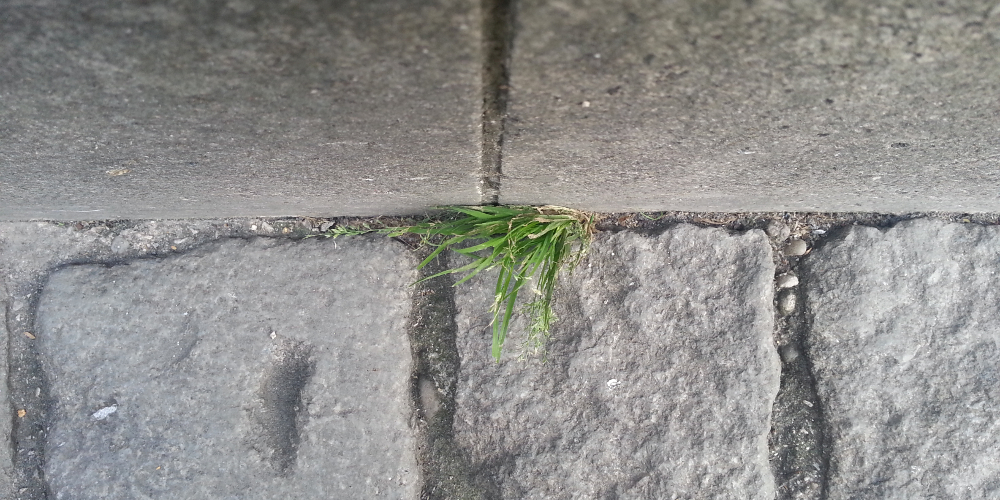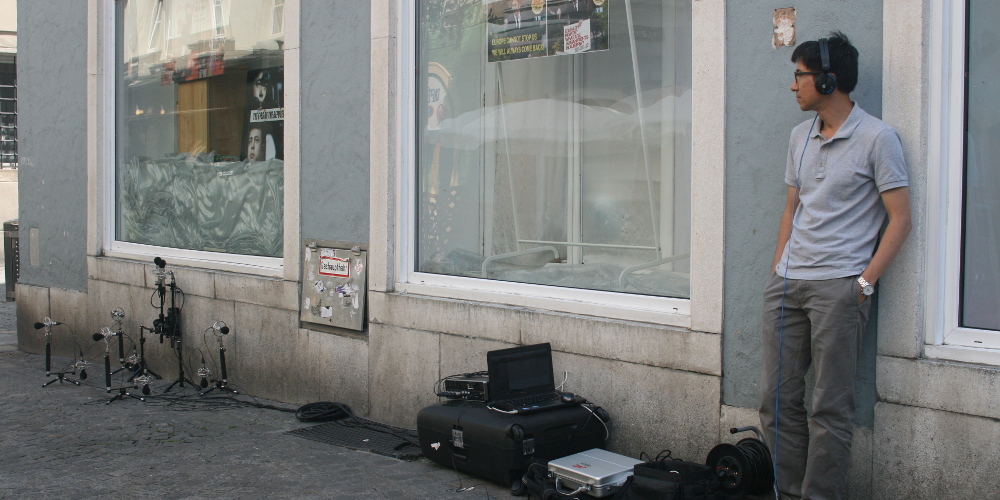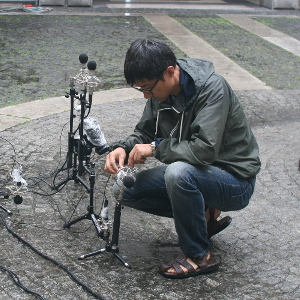On the trail of the feelings of plants, Young Sun Kim goes in the course of his residency stay in the Ars Electronica Futurelab, by presenting sounds from the perspective of little flowers.
 The Ars Electronica Futurelab can look back on many years of thriving collaboration with artists and researchers from all over the world. As for the themes, a great deal of this effort has been invested in transdisciplinary projects at the nexus of art, technology and society. And this is the reason why Ars Electronica is the hub of a huge global network of partners and associates. The Ars Electronica Residency Network (AERN) has been a very successful effort to systematize these interrelationships to offer artists, scientists and partner institutions the opportunity to use the means afforded by a residency program to tackle extraordinary challenges.
The Ars Electronica Futurelab can look back on many years of thriving collaboration with artists and researchers from all over the world. As for the themes, a great deal of this effort has been invested in transdisciplinary projects at the nexus of art, technology and society. And this is the reason why Ars Electronica is the hub of a huge global network of partners and associates. The Ars Electronica Residency Network (AERN) has been a very successful effort to systematize these interrelationships to offer artists, scientists and partner institutions the opportunity to use the means afforded by a residency program to tackle extraordinary challenges.
The latest addition to the residency program lineup is CAT@Ars Electronica staged jointly with the Chungnam Culture Technology Industry Agency (CTIA). CAT@Ars Electronica—short for CTIA Art Technology at the Ars Electronica Futurelab—supports Korean artistic-technological projects by offering the possibility of a residency at the Ars Electronica Futurelab. It targets Korean artists and scientists aiming to develop ideas with tremendous future promise in areas of art and technology. During their residency at the Ars Electronica Futurelab, they can develop their projects amidst an enriched environment conducive to fruitful exchange with members of the Ars Electronica Futurelab’s staff who are able to bring in extensive experience with projects at the interface of art, technology and society.
 The first project under the aegis of CAT@Ars Electronica is entitled “planted – A Media Art with Specially Designed Advanced Sound System & Visual Media” by South Korean artist Young Sun Kim. In this project, he poses a series of questions. “Can pure information be made available with existing media? What if we need pure information derived directly from nature? Media like TV shows and films always manifest the points of view of the producers and directors; is it possible to minimize this production perspective? Would nature then be the medium between God and humankind?”
The first project under the aegis of CAT@Ars Electronica is entitled “planted – A Media Art with Specially Designed Advanced Sound System & Visual Media” by South Korean artist Young Sun Kim. In this project, he poses a series of questions. “Can pure information be made available with existing media? What if we need pure information derived directly from nature? Media like TV shows and films always manifest the points of view of the producers and directors; is it possible to minimize this production perspective? Would nature then be the medium between God and humankind?”
We recently had a chance to interview Young Sun Kim about these issues and about his work at the Ars Electronica Futurelab. And to ask him about what his effort to detect the feelings of plants is all about.
 Young Sun, tell us why you decided to participate in the CAT@Ars Electronica residency program?
Young Sun, tell us why you decided to participate in the CAT@Ars Electronica residency program?
Young Sun Kim: In the area of media art, CAT@Ars Electronica is one of the best residency programs available in Korea. Ars Electronica is a global leader in the development of media art and in providing support to local cities active in the arts and culture. I’m delighted to be able to contribute my experience as an engineer and artist to advancing this development. And I’m happy to have this opportunity to be an artist in residence at the Ars Electronica Futurelab to expand my horizons and to learn from the people at Ars Electronica—not only about technical matters but also about how we channel our energies to create a better future. When you’re presented with such a wonderful chance to be part of something, then you should really take advantage of it. That’s the reason why I decided to take part in this program.
One of the questions you pose in your project description is whether our existing media can provide pure information. What do you mean by “pure information”?
Young Sun Kim: Pure information hasn’t been prejudged by someone. When information reaches us, it stimulates our senses and our thoughts, and there’s this short delay before you react to this stimulus. Between the stimulus and the reaction is the optimal point in time in which information can be input without any prejudgment whatsoever. I believe that the information positioned in this space is pure information.
 Why is it important to receive pure information from electronic media?
Why is it important to receive pure information from electronic media?
Young Sun Kim: Electronic media are very closely connected to our urban way of life. We’re constantly surrounded by it. But during the process of producing the information we receive via electronic media, it’s influenced by the producers’ own views. This massively limits our knowledge. What I expect from electronic media is that they help us expand our knowledge so that we can understand more about our environment and nature. It is very important for electronic media not to restrict us, but rather to help us increase our understanding of nature.
What does your project work have to do with?
Young Sun Kim: This is an effort to represent sound from the perspective of small wild flowers. I’ve been studying sounds and noises for a long time. That’s why I’m interested in the question of what it would be like if flowers had the capacity to perceive noises. How would they hear them and how would they feel while doing so? The little flowers growing at the side of the road are weak and lonely, since they’re constantly at risk of being ignored by people. I can really appreciate these feelings. In South Korea, despite the fact that you’re always surrounded by people, sometimes you could have the feeling that people do not respect your feelings, so you feel lonely and alone. That’s why I designed a sound recording & playback system to reflect how tiny plants might feel.
 What are the largest technical obstacles you face in doing this?
What are the largest technical obstacles you face in doing this?
Young Sun Kim: I capture the sound of the flowers’ environment with a new surround recording technique that functions by means of wave field synthesis in order to make it sound as natural as possible. The development of this technique is the greatest challenge here.
What is wave field synthesis and why are you using it?
Young Sun Kim: Wave field synthesis is a spatial audio playback procedure, the object of which is to create a virtual acoustic environment. The synthesis produces wave fronts that are propagated from a single virtual point. Surround-sound systems that don’t use the wave field synthesis technique have a sweetspot, which means that you get a balanced surround-sound only when you’re positioned right between the loudspeakers. Wave field synthesis, however, makes it possible to produce virtual 3-D sounds that sound much more realistic since they don’t have a sweet spot and thus don’t depend on the listener’s position in the room in which the sounds are being played back.
 What can visitors to the 2014 Ars Electronica Festival expect?
What can visitors to the 2014 Ars Electronica Festival expect?
Young Sun Kim: The visitors can expect to see—or actually, hear—the results of our work. They’ll be able to hear the sound from the perspective of small flowers. This is meant to motivate them to give some serious thought to their environment and their connection to nature.
What will visitors be able to hear?
Young Sun Kim: In a certain way, the sound will resemble what you would normally recognize as ambient noise. But you’ll perceive it in a way that’s totally different than ever before.
 If you too are interested in trying to understand the feelings of plants, you’ll have a chance to do so at the 2014 Ars Electronica Festival September 4-8, when this sound installation will be set up at the Akademisches Gymnasium Linz. Detail will be available online at https://ars.electronica.art/c/programm/.
If you too are interested in trying to understand the feelings of plants, you’ll have a chance to do so at the 2014 Ars Electronica Festival September 4-8, when this sound installation will be set up at the Akademisches Gymnasium Linz. Detail will be available online at https://ars.electronica.art/c/programm/.
